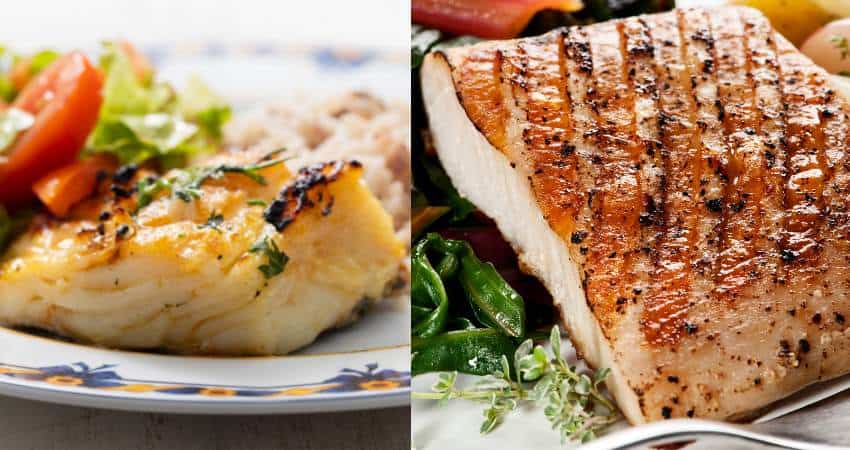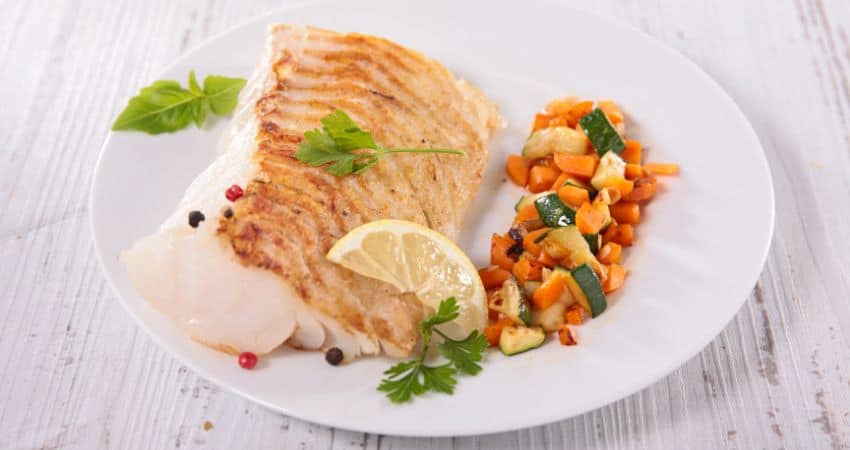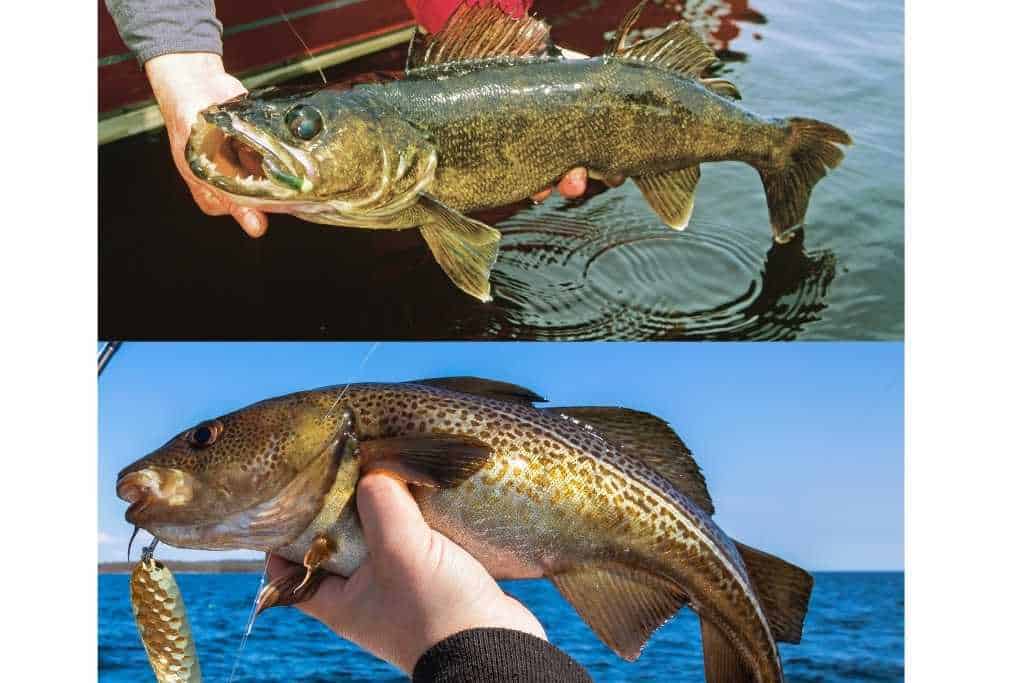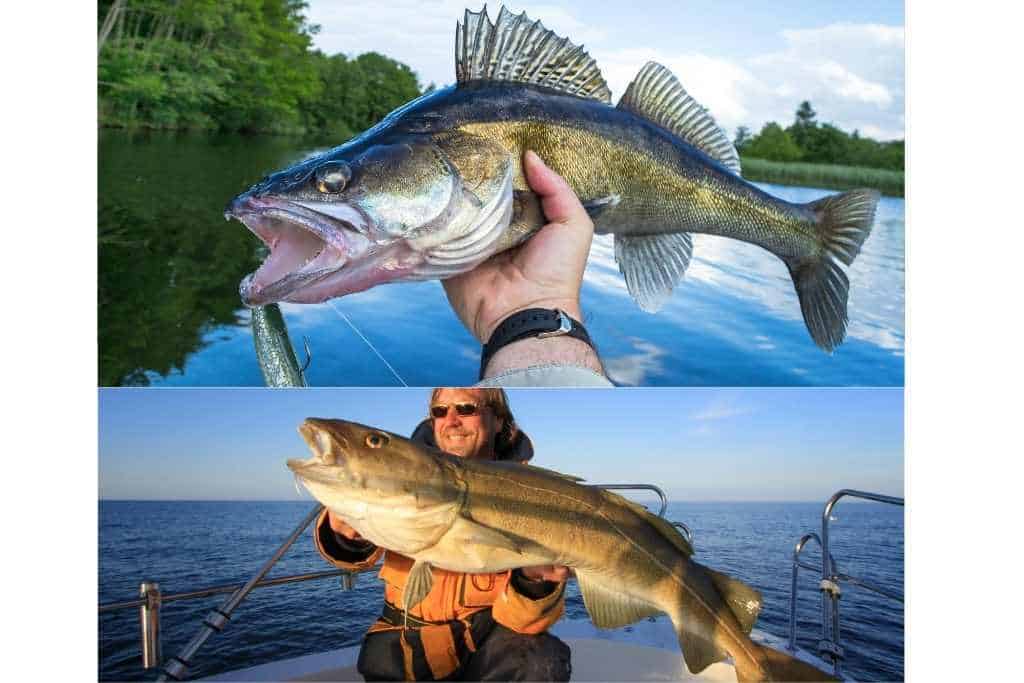Walleye vs Cod – What’s The Difference? Is Walleye Better?
As a Certified Health Coach some clients ask about healthy fish like cod and walleye. They have some similarities but also have differences. You may be wondering, what is the difference between walleye and cod?
Walleye and cod are different species of fish from different families. Walleye is a freshwater fish while cod is found in saltwater oceans and seas. Adult cod grow longer and weigh more than adult walleye. Walleye have dark and gold coloring compared to the light brown coloring on cod.
This article will include a side-by-side comparison of all the vitamins, minerals and nutrients contained in both of them. In addition, I’ll examine their tastes, textures, mercury levels, costs and if one can substitute for the other.

Walleye vs Cod: Nutrition
Below is a nutrient comparison of both per four ounces:
| Nutrient | Atlantic Cod, raw (4 Ounces) | Walleye, raw (4 Ounces) |
| Calories | 93 | 105 |
| Fat | 0.8 g | 1.4 g |
| Saturated Fat | 0.1 g | 0.3 g |
| Cholesterol | 49 mg | 98 mg |
| Protein | 20 g | 22 g |
| Omega-3 | 0.22 g | 0.40 g |
| B-6 | 0.2 mg | 0.1 mg |
| B-12 | 1.0 mcg | 2.2 mcg |
| Thiamin | 0.08 mg | 0.30 mg |
| Riboflavin | 0.07 mg | 0.18 mg |
| B5 | 0.1 mg | 0.8 mg |
| Iron | 0.4 mg | 1.4 mg |
| Niacin | 2.3 mg | 2.6 mg |
| Folate | 7.9 mcg | 17.0 mcg |
| Potassium | 468 mg | 441 mg |
| Magnesium | 36 mg | 34 mg |
| Phosphorus | 230 mg | 238 mg |
| Calcium | 18.1 mg | 124.7 mg |
| Zinc | 0.5 mg | 0.7 mg |
| Selenium | 37.5 mcg | 14.2 mcg |
Nutrient Resources12 ((Nutrition Value: Fish, raw, Atlantic, cod))
Both contain a wide variety of similar nutrients. One contains more of some nutrients while the other contains more of others. Let’s examine which one is healthier.
Walleye is healthier than cod due to its higher percentage of heart healthy omega-3 fatty acids, B vitamins and minerals. Walleye provides more B12, thiamin, riboflavin, B5, niacin, folate, phosphorus, calcium and zinc. They also contain two more grams of protein for every four ounces.
Cod is healthy also and contains a large number of the same nutrients. It provides more B6, potassium, magnesium and selenium.
If walleye is available, I’ll choose it more often to eat due to its nutrients. Most of the time it’s not and I’ll purchase and cook the other which is still beneficial.
The next section explains how these nutrients benefit health. Especially omega-3 fatty acids which walleye contains almost double of.

Health Benefits
Walleye Health Benefits
Omega 3 Fatty Acids
It provides 0.40 grams of omega-3s per four ounces. The omega-3 fatty acids help keep arteries healthy and are considered heart healthy.
The omega-3s may help with the following:
- Lowering triglycerides.
- Reduce inflammation.
- Reduce plaque buildup.
- Keeping bad cholesterol low.
- Keeping good cholesterol high.
- Help keep the heart rhythms more normal.
DHA and EPA, two of the fatty acids, are associated with lowering blood pressure and improving the health of blood vessels ((National Center for Biotechnology: Marine Omega-3 Supplementation and Cardiovascular Disease)).
Studies suggest omega-3s boost the effectiveness of anti-inflammatory drugs.
In addition, they’ve been shown to help reduce joint pain and stiffness in people with rheumatoid arthritis.
B Vitamins
They provide more of six of the seven B vitamins listed below.
The B vitamins provided include the following:
- B1 (thiamin)
- B2 (riboflavin)
- B3 (niacin)
- B5
- B6
- B9 (folate)
- B12
B vitamins help support the following:
- Digestion.
- Brain function.
- Energy levels.
- Red blood cells.
- Cardiovascular disease.
- Nerve function.
Phosphorus
They provide 238 mg of phosphorus. It has been shown in scientific research to help with the following:
- Promote teeth and bone strength.
- Muscle recovery after exercise.
- Muscle contraction.
- Help the body store and manage energy.
- Help the kidneys remove waste.
- Promote healthy nerve conduction.
Calcium
It is important for blood pressure and the heart. Harvard Health reports calcium helps maintain blood pressure because it helps to control the relaxing and tightening of blood vessels3.
In addition, calcium helps the following:
- Build and maintain strong bones.
- Muscles need calcium to function properly.
- Improve nerve function.
Cod Health Benefits
Magnesium
They provide 36 mg of magnesium. It helps to calm and relax the whole-body including blood vessels. It has been shown to help improve sleep related problems like insomnia4.
Magnesium helps keep blood pressure levels balanced and stable. A recent study researched 22 studies and concluded magnesium supplementation decreased diastolic and systolic blood pressure5.
Magnesium helps control muscle and nerve function, blood sugar and blood pressure. In the muscles and heart, magnesium competes with calcium to help the muscles relax after contracting.
When the body is low in magnesium, calcium can over stimulate the heart muscle’s cells causing a rapid or irregular heartbeat.
Selenium
It provides 37.5 mg for every four ounces. Selenium is a nutrient which doesn’t receive much press. I’m unsure why many people don’t write about it more. Many studies6 show selenium may help to protect the following:
- Cognitive issues
- Heart disease
- Thyroid
- The immune system
Potassium
Potassium helps the body get rid of excess sodium which helps reduce fluid build-up. The result keeps systolic and diastolic blood pressure lower7.
The more potassium you consume, the more sodium your body will lose. Consuming too much sodium or not enough potassium throws off the delicate balance the kidneys need to remove the excess water8.
According to Harvard Health, a number of studies have shown a connection between low potassium levels and increased blood pressure9.
Tastes and Textures
One of the main reasons people chooses a particular one is the fish taste. When comparing the two, let’s find out how their taste compares.
Walleye tastes mild to sweet compared to cod’s mild taste. At times walleye may have a slight fishy flavor depending on where the fish was caught. They both have a firm texture which is smooth and flakey.
To conduct original research on taste, I polled my readers, clients and members of food groups I belong to.
Is walleye taste better?
The following are the results of my poll which consisted of 32 people. I asked if walleye taste better?
- 44% preferred the taste of walleye.
- 37% preferred the taste of cod’s mild flavor.
- 19% said they had no preference between the two.
I thought it would be fun to set up a taste test at home. I conducted a blind taste test of each fish prepared the same way. The results were similar to the poll above.
Check out the differences with white perch in my recent article recent article.
Substitutions
When preparing recipes for dinner you may have one already in the refrigerator ready to be used. In addition, it’s not always possible to locate the type called for in the recipe.
You may be wondering if you can use a Wallace fish for a cod sandwich. Let’s see if you can substitute one for the other.
Cod and walleye can substitute for each other due to their similar mild to sweet tastes and firm textures. Both of them can be used in many of the same recipes and cooking methods. They both can be cooked by baking, broiling, steaming, grilling and frying.
Walleye fish substitutes include the following:
- Halibut
- Catfish
- Yellow perch
- Snapper
- Grouper
- Tilapia
Other cod substitutes for fish fry or other meals include the following:
- Halibut
- Tilapia
- Haddock
- Pollock
- Striped bass
- Mahi mahi
When substituting always stick to the following:
- Same size and weight.
- Stick with similar fillets, whole fillet or cross section.
- Stick with skinless or skin when the recipe calls for one.
- Texture is more important for certain cooking methods. Like using a firmer texture when grilling10.
Sauger may be more similar. Find out how people can tell the difference between the two in my article, Let’s Compare.
Cost
The costs will vary depending on how they are caught and where they are sold. When purchasing, be sure to check the label to see if it is wild-caught or farm raised. Therefore, which is costs more?
Walleye cost more per pound than cod. The average cost for fresh walleye fillets is $18.65 per pound. The average costs for fresh cod fillets are $12.99 per pound.
To conduct more original research, I checked online and found the following prices:
- Wild, walleye fillets
- $19.80 per pound
I checked Whyte’s Fishery online and found the following prices:
- fresh walleye fillets
- $17.50 per pound
- Fresh cod fillets
- $12.50 per pound
Fresh Direct online:
- Wild Atlantic cod
- $13.49 per pound
I also checked the prices in my local supermarket but wasn’t able to find both of them at the same store.
Mercury Levels
The EPA and The Food and Drug Administration have issued warnings and suggestions regarding mercury levels in fish and how often they should be consumed11. This is especially important for the following:
- Pregnant women
- Developing children
- Young infants
They established a list of the following:
- Best fish
- Good choices
- Fish to avoid
Therefore, which one has more mercury?
Cod and walleye have similar levels of mercury. They are listed on the FDA’s best choice of fish regarding mercury levels.
If you’re pregnant, breast feeding or has a young child, always check with a physician prior to eating new foods or changing your dietary habits.
Mercury warnings can change over time or affect only a particular area or state. Please check with your local EPA and FDA for the current recommendations12.

Habitats, Size, Weight and Appearance
To tell the difference between a walleye and cod is to check their dorsal fins, anal fins and body markings. Walleye have two dorsal fins while cod have three. Walleye have one anal fin while cod has two. Walleye have dark bands on the upper sides of their body. Cod has small dark spots on their sides.
Scientific Classifications, Families, Species
Walleye are from:
- Family: Percidae
- Genus: Sander
- Species: S. vitreus
- Common nicknames: Yellow pike, yellow pickerel.
Pacific cod are from:
- Family: Gadidae
- Genus: Gadus
- Species: G. macrocephalus
- Common nicknames: Gray cod, gray fish.
Atlantic cod are from:
- Family: Gadidae
- Genus: Gadus
- Species: G. morhua
- Common nicknames: Cod, codling.
They are different species from different families of fish.
Habitats
Walleye Habitats
- They are native to Canada and North America. They can be found in Canada, the Great Lakes, Hudson Bay, the Mississippi River basins from Canada, New York down south to Alabama and Arkansas.
- They can be found in lakes, reservoirs and rivers.
- They prefer large, shallow lakes and are rarely found in brackish waters.
Cod Habitats
- Pacific is found in the North Pacific Ocean from the Bering Sea to California in the east and to the Sea of Japan in the west.
- Atlantic is found in the Northwest Atlantic Ocean from Greenland to North Carolina and in the western Gulf of Maine.

Appearance
Colors
- Walleye have a dark, olive green back with olive green to golden sides. The coloring on the sides fades towards the white belly. There are five dark bands crossing over the back and upper sides.
- Atlantic is brownish, greenish to light yellowish with small, dark spots and a light lateral line running down the body.
- Pacific is brownish or grayish with dark spots with a cream lateral line running down the body.
Dorsal Fins
- Walleye has two dorsal fins. The front dorsal has about 12 spines and the second dorsal has 10-13 soft rays.
- Cod has three dorsal fins. The first dorsal is taller and all three have soft rays.
Anal Fins
- The walleye one anal fin has soft rays with no spines.
- Cod has two anal fins both with soft rays.
Tail Fins
- The walleye tail fin is slightly forked.
- The cod tail fin is unforked.
The lower rear tip of the walleye tail fin is white.
Mouth
- The walleye mouth is large but doesn’t extend past the eye line. The lower jaw protrudes.
- The cod mouth is large but doesn’t extend past the eye line. The upper jaw protrudes over the lower jaw.
Distinguishing Marks
- Walleye has dark bars or saddles running from the upper sides over the back. Their eyes are large, pearlescent and opaque. Their caudal and anal fins have white colored tips.
- Cod has dark spots on the side of their body. They have whiskers on the lower jaw.
Body Shape
- The walleye body is long, thin and round.
- Cod are heavily bodied and long.
Size and Weight
- Walleye average 22 inches long and weigh up to 20 pounds.
- Cod average 25 to 42 inches long and weigh up to 26 pounds depending on if they live near the shore or offshore.
Lifespan
- Walleye lives up to 10 years.
- Cod lives up to 20 years.
Diet
Walleye consume the following:
- Insects
- Worms
- Small fish
- Yellow perch
- Minnows
- Frogs
- Crayfish
- Large invertebrates
Cod consumes the following:
- Sea worms
- Sand eels
- Herring
- Mackerel
- Young haddock
- Capelin
- Mollusks
- Crustaceans
Their diets differ due to the freshwater environment of the walleye and the ocean environment of the cod.
The following video explains how to cook walleye easily.
If you have any questions about this article don’t hesitate to email us. You can find an email on our contact page.
In addition to informing my clients about cod and walleye, I have researched, purchased and consumed both fish for 20 years prior to, during and after writing this article.
Read Next – More Fish Articles!
Sea Bass vs Cod – Is One Better? Let’s Compare
Pacific Cod vs Atlantic Cod – What’s The Difference?
Pacific Cod vs Sockeye (Pacific Salmon) Which Is Better?
Alaska Pollock Vs Cod: A Comparison – Which Is Better?
Cod Vs Tilapia – A Complete Comparison
- Nutrition Value: Fish, raw, walleye, pike [↩]
- USDA: Fish [↩]
- Harvard Health: Key minerals to help control blood pressure [↩]
- National Institutes of Health: Magnesium [↩]
- National Center for Biotechnology Information: Effect of magnesium supplementation on blood pressure: a meta-analysis [↩]
- National Institutes of Health: Selenium [↩]
- American Heart Association: How Potassium Can Help Control High Blood Pressure [↩]
- National Center for Biotechnology Information: The Effect of the Sodium to Potassium Ratio on Hypertension Prevalence: A Propensity Score Matching Approach [↩]
- Harvard Health: Potassium lowers blood pressure [↩]
- Sea Grant North Carolina: Fish Flavors and Substitutions [↩]
- FDA: Advice about Eating Fish [↩]
- National Center for Biotechnology Information: Mercury accumulation in largemouth bass (Micropterus salmoides) in a Florida lake [↩]
